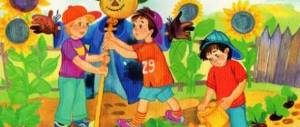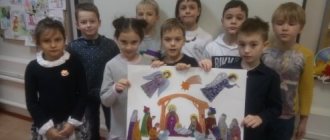- Reports and messages
- Miscellaneous
- Christmas
The Nativity of Christ is the main holiday for Christians, which Catholics celebrate on December 25, and Orthodox Christians on the magical night of January 6-7, although no one knows the exact date of Jesus’ birth.
Until the end of the 4th century, Christmas was celebrated on January 6, and this holiday was called Epiphany. The basis of this date is the birth of Jesus Christ, the messenger of God, in human flesh, who came to Earth to save humanity from sins.
Jesus is the son of a simple carpenter Joseph and the Virgin Mary. The history of the holiday begins from the moment when an angel came down to Mary and said that she would soon give the world God's messenger. On the eve of giving birth, Mary and Joseph went to Bethlehem, but when they stopped to spend the night in a stable, Mary gave birth to Jesus. The baby had to be placed directly in the manger (a manger is a bowl from which animals eat hay). All the shepherds received news from the angels that the Savior was born, and they came to worship him and brought gifts, and a bright star lit up in the sky. The news of the birth of the Son of God quickly spread, and when King Herod found out about it, he issued a decree to kill all children under 2 years of age. But an angel warned Joseph about this, so they managed to hide Jesus in Egypt, where they lived until the death of Herod.
In Russia, the Nativity of Christ has always been considered great, but when the Soviets took power, religions began to be rejected, all churches were closed, only after 1991 the holiday was returned to its importance.
It is very important on this holiday that on the eve of Christmas a long and strict fast is observed, which lasts 40 days. And on January 6, it is customary not to eat anything until the first star, as a reminder of the star that lit up in the sky in honor of the birth of Jesus. During fasting, you cannot eat meat, eggs, milk and other products that animals give us. On some days, fish and vegetable oil are allowed. The main meaning of fasting is to cleanse not only the body, but also the soul, so during fasting you should not offend anyone or quarrel.
The last day of Lent is considered to be Christmas Eve, that is, the night of January 7, when people completed preparations for the holiday. And the name Christmas Eve comes from the Lenten dish - sochivo. It was made from oats, wheat and rice, with fruits and nuts added. In total, on Christmas Eve there should have been 12 dishes on the festive table - according to the number of Jesus’ apostles.
An interesting fact is that previously the tree was a symbol not of the New Year, but of Christmas, and Christmas trees were decorated with candles, apples and gingerbread cookies. But the main attribute of the green beauty was a star, which meant the Star of Bethlehem, which showed the way to the Magi to Jesus, and the star was seven-pointed.
A common pastime among children was carols, as funny songs were called. The children went from house to house and sang songs, and in return received sweet gifts. It was believed that the more children came to the owner of the house to carol, the happier his house would be in the coming year.
Christmas has finally become a special holiday in every home again; folk fortune-telling and beliefs are very common at Christmas, because this holiday in itself is magical.
Report No. 2
Orthodox believers traditionally celebrate Christmas on January 7th. This is the birthday of our Savior, the God-man, Jesus Christ.
Christ was born in very simple conditions, in a barn, an animal feeder served as his cradle, and fresh hay replaced his diapers. The simple conditions of God’s birth symbolize his closeness to people, Christian humility and simplicity.
Simple shepherds came to worship God, to whom an angel who appeared to them told the good news. The wise Magi also traveled a long way to greet the Savior; the Star of Bethlehem showed them the way. The Magi presented luxurious gifts to the God-Man.
By tradition, Christmas is a cozy and homely holiday, which is usually celebrated with family. Since ancient times, pork dishes, baked poultry and fish have been placed on the Christmas table. On this holiday, it is customary to pamper the family with homemade baked goods, but they do not sit down to the table until the first star lights up in the sky. Before her appearance in heaven, believers observe strict fasting. The first star symbolizes the Star of Bethlehem, which served as a guiding thread for the Magi.
The period from January 7 to January 19 is called “Yuletide.” These are the only days of the year when fortune telling is allowed by the church. During this period, unmarried girls make fortunes about their “betrothed.” There are a huge number of types of Christmas fortune-telling, some have come down to us from time immemorial, others were introduced into use relatively recently.
A well-known Christmas tradition is caroling, which means “to praise Christ.” On Christmas Eve, the mummers went from house to house, put on funny performances and received treats from the owners of the house. Unfortunately, now this good tradition is almost completely a thing of the past.
The tree has long been a symbol of the Christmas holidays. Since ancient times, it has given people a feeling of celebration and the promise of bright changes. There is an interesting sign: the more varied and plentiful the table at Christmas, the more successful the family will be in the coming year. Therefore, be sure to celebrate Christmas in a big way, happy upcoming holiday!
4, 5, 7 grade
Project “Nativity of Christ” (preparatory group)
Evgenia Meleshchenko
Project “Nativity of Christ” (preparatory group)
Project “
Nativity of Christ ” (
preparatory group ) Prepared by teacher : Meleshchenko E. S.
In the whole world there is a celebration -
Christmas has come .
Project type : short-term, educational - speech, creative
Implementation period: short-term (January)
Project participants : children of the preparatory group , parents, teachers.
Relevance of the topic. Currently, at the federal level, the tasks of spiritual and moral education are being updated, which are disclosed in state regulatory documents: “Concepts of education and personal development of a citizen of Russia”
, “Federal State Educational Standard for Primary Education”, which highlights the subject area
“Spiritual and moral culture of the peoples of Russia”
. It is necessary from childhood to pay attention to the mental and spiritual world of children. The soul of a modern child chooses for its use love, kindness, warmth of family, honesty, decency of friends, reliability, strength of a common home - the Motherland.
Project hypothesis : Children will develop a desire for morality and sincerity.
Goal: Introducing children to the origins of Russian folk culture.
Tasks:
1. Form an idea about Christmas , Christmastide , carols. Develop the emotional sphere of the child. Develop children's creative abilities.
2. Activate speech through oral folk art: carols, poems, riddles. Expand children's vocabulary with words: Nativity , Christmas story , nativity scene, carols; texts of carols, poems, stories and fairy tales on the topic of the project .
3. Cultivate a love for Russian folk culture and customs.
Integration of educational areas: cognitive, artistic and aesthetic, speech, social and communicative development.
Preliminary work with children:
•Conversations: “ Christmas ”
,
"Christmastide"
,
"Kolyada"
.
• Conversations on paintings by Russian artists A. Savrasov “Winter Landscape”
, P. Sokolov
“Troika in winter”
.
• Learning carols, poems, riddles.
1 - Stage - preparatory :
Goal: creating organizational conditions that ensure the implementation of the project .
Contents of activities and expected results:
1. Study of effective pedagogical experience in working with preschoolers within the framework of the project .
2. Drawing up a long-term thematic plan for the implementation of the project .
4. Selection of material on the topic. (Bank of illustrations, poems, songs, stories about Christmas , crafts).
5. Preparation of methodological support for the project “ Nativity of Christ ”
.
6. Enrichment of the subject-spatial environment in the group
Group registration :
1) Exhibition of Christmas cards .
2) Corner “
Nativity ” (nativity scene)
3) Exhibition of books on a Christmas theme .
7.Making educational games: “Good and Evil”
,
“What is good and bad”
2 - Stage of work - main
Goal: implementation of pedagogical work.
Contents of activities and expected results:
1. Conducting conversations.
2. Reading instructive stories, E. T. A. Hoffmann’s fairy tale “The Nutcracker”
T. Dowley " Christmas Night "
,
“
Christmas Star ” , P. Bazhov
“Silver Hoof”
;
L. Medvedev “On Christmas Eve”
;
A. Pleshcheev “Christmas tree at school”
;
O. Efremova "
The Nativity of Christ " .
“The First
Christmas Night ” ,
“
The Birth of Christ ” ,
“
Christmas Angel ” ,
“The Star Leading to Bethlehem”
3. Memorization of poems: K. Balmont “Snowflake”
,
"
Christmas " ;
learning Christmas songs and carols , “
A Christmas Story ” .
Poems on the theme “
Christmas ” , carols. Learning poems on the theme:
“
The Nativity of Christ ” .
4. Preparation of the presentation “Carols”
.
5. Making and solving riddles.
6. Bible coloring books: (They will learn to do shading and choose the right color scheme)
.
7.Applique on the theme: “ Christmas Angel ”
.
8. Paper construction “ Christmas Angel ”
.
9.Drawing on the theme: “ Christmas ”
;
drawing on the theme “Winter fun”
;
making masks for caroling rituals; making gifts and festive Christmas cards ; paper construction: “Candle”
;
making a nativity scene (with the help of parents)
. Children will learn to use various techniques and means to convey the plot.
10. Conversation on paintings by Russian artists: B. Kustodiev “Fair”
;
A. Kievshenko “Carols”
(illustration for Gogol’s story
“The Night Before
Christmas ” ).
11. Modeling “Star of Bethlehem”
(Use of various non-traditional sculpting techniques, development of fine and gross motor skills in the sculpting process).
12. Joint work of children and parents to make crafts on the theme: “ The Nativity of Christ ”
13. Situational conversation: “What should you do in this situation?”
(Children learn to control themselves, to look at themselves from the outside before doing something).
14. Carrying out outdoor games “Golden Gate”
,
“Happy Tambourine”
,
“Two Frosts”
,
15. Role-playing games: “The family celebrates the holiday”
;
"House"
.
16. Listening to and familiarizing with musical works: P. Tchaikovsky “December-Christmastide”
from the series
“Seasons”
;
M. Glinka “Kamarinskaya”
.
17. Watching videos: “12 months”
,
“The Snow Maiden”
,
“A Tale at
Christmas ” .
18. Theatricalization of “ A Christmas Tale ”
for guests from the budgetary institution of the Omsk region “Comprehensive Center for Social Services for the Population “Rodnik” of the Lenin Administrative District.”
Objective: To expand the understanding of preschool children about the traditions of the Christmas .
3 — Stage — Final
Goal: summing up the implementation of “ Nativity ” project
.
Conclusion: the celebration of the Nativity of Christ unites people who believe in goodness and are ready to do good deeds. Christmas is a day of reconciliation , kindness, peace. This is a holiday of affirmation of love on Earth, joy, light.
Contents of events:
1. Holding a holiday on the theme “ Christmas ”
2. Exhibition of joint works of children and parents on the theme “ Christmas ”
Planned result:
1. Sustainable knowledge and interest in the history of the Nativity of Christ . Interest in the Christmas , and ideas about the traditions of its celebration have expanded.
2. There is a positive trend in children’s acquisition of cognitive and speech skills. The level of use of specialized terms on the topic of the project in speech : without gross errors, violations of norms - pronunciation, grammatical, lexical. The children's vocabulary has expanded.
3. Partnership relationships have been established between children and parents, thanks to joint activities.
Result: In conclusion, we can draw conclusions that all the work done was aimed at the active acquisition by children of the cultural wealth of the Russian people, at the formation of an emotionally charged sense of children’s involvement in the heritage of the past. The basis of human culture is spirituality. Therefore, the acquisition by a child of a set of cultural values contributes to the development of his spirituality - an integrated personality trait that manifests itself at a level that determines the measure of his overall development. Children use the acquired skills for the further development of cognitive and creative activity. Once they enter school, they find additional activities for themselves and continue to study in various clubs and studios (music, vocal, art, dance)
.
Used Books:
1. Blinova G. P. “Russian folk holidays”
. M.: University Book, 2020.
2. Gavrilova I. G. “The origins of Russian folk culture in kindergarten”
. St. Petersburg: Detstvo-Press, 2020.
3. Dine G. “Children’s folk calendar”
. M.: Children's literature, 2014.
4. Doronova T. N. A “Playing at the theater”
. M.: Enlightenment, 2020.
5. Zatsepina M. B., Antonova T. V. “Folk holidays in kindergarten”
. M.: Mosaika-Sintez, 2020.
6. Istomin S.V. Encyclopedia “I get to know the world. Russian people: traditions and customs”
. M.:AST:Astrel: Guardian, 2020
7. Kapranova L. N. “Grandma’s fun”
.Rostov on Don: Phoenix, 2014.
8. Lyalina L. A. “Folk games in kindergarten”
. M.: Sphere shopping center, 2020
9. Kharlitsky M. S., Khromov S. S. “Russian holidays, folk customs, traditions, rituals”
. M.: Publishing house of the Russian Peoples' Friendship University, 2016.
10. Shchetkin A. V. “Theatrical activities in kindergarten”
. M.: Mosaika-Sintez, 2020.
11. Magazines “Svechechka”
2014, 2020. 2020
12. Levkodimov G. E. “ Christmas tree ”
, JSC RIFME, Moscow, 2020
13. Tikhomirova L. F. Exercises for every day: developing the attention and imagination of preschoolers. Yaroslavl: Academy of Development, Academy, K. 2015
Popular message topics
- City of Samara
Ah, Samara is a town,……. How many songs have been written, how many poems have been written about such a beautiful city in the Volga region - Samara. The city is truly beautiful in its own way, it is the pearl of the Volga region, having a rich historical heritage of Russia. - Scientists
Scientists are people who have made important contributions to science. They make discoveries and conduct research in various fields of science. Thus, scientists can be divided into several categories: physicists, chemists, mathematicians, philologists, astronomers, - Habitat of organisms
What is a habitat? This is nature around living beings. It is it that provides everything necessary for life (food, conditions for life and reproduction) and it is into it that organisms secrete metabolic products.
Presentation on the theme "Christmas"
Christmas
The history of the holiday
In the Christian Church, from the end of the 2nd century until the 4th century, the events of Christmas were remembered on the day of Epiphany - January 6. Around the year 200, Clement of Alexandria mentioned this practice. The first reports of the appearance of a separate holiday of Christmas and its celebration on December 25 date back to the middle of the 4th century [2]. According to one version, this was due to the desire of the Christian church to supplant the cult of the Invincible Sun, widespread in the Roman Empire, whose birth was celebrated on December 25 - then the winter solstice fell on this day.
Dates of celebration in various churches
The Roman Catholic Church and most Protestant churches celebrate December 25 according to the modern Gregorian calendar.
The Russian, Jerusalem, Serbian, Georgian Orthodox churches and Mount Athos, as well as the Eastern Catholic churches, celebrate December 25 according to the Julian calendar (the so-called “old style”
), which corresponds to January 7 of the modern Gregorian calendar.
Constantinople (except Athos), Antioch, Alexandria, Cyprus, Bulgarian, Romanian, Greek and some other Orthodox churches celebrate December 25 according to the New Julian calendar, which until March 1, 2800 will coincide with the Gregorian calendar, that is, simultaneously with other Christian denominations celebrating Christmas according to the “new style”.
Ancient Eastern churches celebrate Christmas on January 6 on the same day as the Epiphany under the common name of Epiphany.
States in which Christmas is a day off
One day off
- Armenia – January 6
- Brazil — December 25
- Georgia – January 7
- Jordan - December 25
- Kazakhstan - January 7
- Kyrgyzstan - January 7
- Macedonia - January 7
- Mexico - December 25
- Portugal — December 25
- Russia - January 7 (since 1991 [19] ) [2 0]
- Republic of Korea - December 25
- Serbia - January 7
- USA - December 25
- France - December 25
- Ukraine – January 7
Russian Christmas Eve
Christmas has been celebrated in Rus' since the 10th century. The evening from January 6 to 7 was called Christmas Eve. It was preceded by a strict fast that began on November 28. During these days, it was forbidden to eat anything fatty or meat until the first star appeared on January 6 - a symbol of the birth of Christ.
The first dish on the table was kutia, a sweet porridge made from rice cereal. The Christmas table was distinguished by its abundance. They invited as many guests as possible to the house, sang carols, and provided those who came with sweets, pastries, and sausages.
They always put “sochivo” on the table - a dish similar to kutya, but made from wheat grains. An indispensable attribute in the home was a sheaf of hay as a memory of the manger in which Christ was born. Homemade wine, beer, and brew were served as drinks.
Pagan traditions are clearly visible in the celebration of Christmas in Rus'. It was customary to light bonfires in honor of the victory of good over evil spirits. After January 7, the week of Christmastide began.
This period was considered the best for fortune telling, and all dreams that could be seen at this time were perceived as prophetic. And the carols and sowings themselves, which we still love so much, are nothing more than a tribute to the pagan god Kolyada, who personified the sun, which turned to spring.
This is how you and I are still at the mercy of different ideas about the world, but they coexist perfectly in our life and in our soul.
German entertainment
In Germany, as throughout Catholic Europe, Christmas is celebrated on the night of December 24-25, but preparations take place a month before the holiday. This period is called “Advent”. A solemn service is held in churches, communion and repentance are performed.
The Germans love to decorate their premises with fairy-tale “nativity scenes” - small scenes based on Christmas themes. Here is the cave in which Christ was born, and the Christmas star, and even the Magi. Candles entwined with ribbons and biblical figures are hung on the doors.
A mandatory attribute is the branches of the mistletoe coniferous tree, from which round wreaths are woven and placed on the walls.
Toys in the shape of cucumbers and carrots are hung on the Christmas tree. Children must find cucumbers hidden in the needles, for which they receive additional gifts. Carrots are usually given to newlyweds as a symbol of well-being in the family.
And how can we do without Santa Claus, who brings gifts to children? Unlike the Russian Father Frost, he comes at Christmas, not New Year. On the eve of the holiday, it is customary to visit fairs where edible chestnuts, mulled wine, chocolate, and honey gingerbread are sold in abundance. Children are bought beautiful clothes and new clothes.
Each region of Germany has its own customs that differ from the generally accepted ones. And now we’ll find out how Christmas is celebrated in another European country, interesting for its traditions - France.
French log
In many ways, Christmas traditions in France coincide with those in other Catholic countries:
- the spruce is decorated with toys and balls;
- Christmas “dens” are installed in the home;
- Christmas-themed mini-performances are staged in churches.
Here are some interesting facts that are specific to French celebration customs.
Interesting facts about Christmas in France
- Instead of Santa Claus, Pere Noel comes to the children. This character was “brought” to France by American soldiers during World War II.
- Another tradition appeared in France a long time ago, when logs were lit in fireplaces for heating in homes. At Christmas, they took the best log, carried it around the table with sentences, and then put it in the fireplace. Today, the real log has been replaced by a tasty roll of similar shape.
- In general, much attention is paid to the table in France. There are sweets, champagne, turkey and other delicious dishes.
Father Christmas from England
Christmas traditions in England may differ slightly from those in Europe, since the country is located on an island and contrasts itself with the rest of the continent. Instead of Santa Claus and Peer Noel, Father Christmas brings gifts to the children.
At night he puts souvenirs in children's socks, and the next morning the kids and their parents run into the living room to see what the fairy-tale hero brought them. To appease Father Christmas, the children prepare for him a piece of meat pie, a glass of milk and a carrot.
Celebrate Christmas with family. Guests gather for lunch and celebrate around lunchtime. At the same time, the Queen's speech is broadcast on television. Traditionally, appetizers are served, followed by turkey cooked in currant sauce. For dessert - Christmas cake.
The main Christmas tree of Great Britain is installed in the main square of England - Trafalgar Square. Public celebrations also take place here. The day after Christmas is dedicated to St. Stephen. At this time, it is customary to give money and donations to the poor.
American generosity
In America (USA), Christmas is marked by massive lights and decorations on the streets. The homes of ordinary Americans are not far behind the shops, firms and various organizations. It has become a good tradition to hang an elegant wreath on the outside of the door of the house.
Americans give each other a huge number of gifts. It is for this reason that on the eve of Christmas, stores offer huge discounts, thanks to which high-quality products can be purchased at a price 2-3 times less than the usual price.
At home, Christmas is celebrated with close friends and relatives. Appetizers, salads, roast goose or turkey, pie or pudding are served on the table.
But no matter what Christmas is like in different countries, it is united by a common tradition for all northern peoples - to celebrate the turning of the sun into spring and the victory of good over evil, as it originated in pagan times and only changed form with the advent of Christianity.
).
Celebration of Christmas by non-Christians
Among non-Christians, many cultures associate Christmas primarily with the tree, gift-giving, and making wishes. The custom of giving gifts at Christmas is strongly encouraged by sellers, which has led to the commercialization of Christmas. In the period leading up to Christmas, specialty store revenues can account for half or more of the rest of the year.
In most countries of the world, Christmas is a public holiday, or this day is declared a day off. This has been criticized by some members of other faiths and atheists as a violation of the right to freedom of conscience and the separation of religion and state. It should be noted that in countries where Christmas is not a national holiday, as a rule, holidays of other religions are established as public holidays (Morocco) or residents are deprived of the right to freedom of religion and state atheism is established on a communist model (China).
In the United States, public figure and atheist Richard Stallman proposed celebrating Isaac Newton's birthday on December 25 as a symbol of the triumph of human science.
In the Soviet Union and Russian Federation
Main article: Christmas in Russia
In the Soviet Union, until 1929, Christmas was a public holiday and a day off and was celebrated according to the Gregorian calendar, but after weekends on religious holidays were abolished, most Christmas customs (tree, gifts) switched to New Year celebrations. [28]
Once again, Christmas Day became a day off in 1991: in December 1990, the Supreme Soviet of the RSFSR issued a decree declaring the Orthodox holiday of Christmas a non-working day [19]. Already January 7, 1991 was a non-working day. However, in some republics of the RSFSR, for example, the Tatar Autonomous Soviet Socialist Republic, this decree was ignored, and the day was recognized as a working day [29].
On the federal channels of Russian television, a solemn service is broadcast on Christmas night (after the restoration of the temple - from the Cathedral of Christ the Savior).








